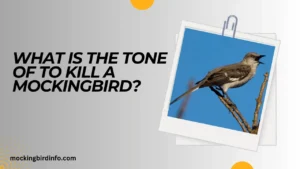The Power of Simile in Literature: In Harper Lee’s To Kill a Mockingbird, similes act as more than just literary decoration; they are pivotal in shaping the narrative’s tone and fostering connections between readers and characters.
The line, “a figure in a horror story,” is just one of the many instances where Lee’s precise language invites readers to visualize the hidden truths of Maycomb’s community. Similes like this enrich the story’s complex themes of prejudice, courage, and moral growth.
Why Similes Matter: The use of similes isn’t merely for artistic flair—they allow readers to dive into the psyche of characters and understand scenes with greater emotional resonance.
By comparing one thing to another, Lee provides subtle clues that deepen our grasp of the novel’s social and emotional fabric. In a story that navigates racial injustice, childhood innocence, and the clash between good and evil, similes enhance how we perceive and empathize with the characters.
A Path to Understanding: This blog will focus on a specific simile that encapsulates the harshness of human nature and its implications for the novel’s deeper themes. By exploring its context, literal and figurative meanings, and broader significance, you’ll see how Harper Lee’s choice of language transforms a simple comparison into an unforgettable part of the story.

Contents
- 1 1. The Chosen Simile
- 2 2. The Figurative Meaning
- 3 3. The Simile’s Role in the Novel
- 4 Conclusion:
- 5 FAQs
- 5.1 1. Why does Harper Lee use similes in her writing?
- 5.2 2. What makes the “rusty gate” simile so powerful?
- 5.3 3. How do similes enhance character development?
- 5.4 4. What themes does the “rusty gate” simile touch on?
- 5.5 5. Can similes affect how readers connect to the story?
- 5.6 6. What role does sensory imagery play in similes?
1. The Chosen Simile
Simile Overview: One simile that stands out in the novel is Scout’s description of Mrs. Dubose’s voice as “a rusty gate swinging shut.” This simile is more than a passing description; it is an image loaded with meaning that sets the tone for Mrs. Dubose’s character throughout the book.
Context of the Simile: Mrs. Dubose is introduced as an irritable, elderly woman who verbally assaults Scout and Jem as they pass her house. This comparison arises when Scout reflects on her encounters with Mrs. Dubose, capturing the abrasive and grating nature of her voice and demeanor.
The scene serves as a critical backdrop that helps readers understand Scout’s initial fear and later realization of Mrs. Dubose’s complexity.
Literal Elements: On a literal level, a “rusty gate” implies something old, corroded, and difficult to move. The sound it makes—a loud, creaking noise—is unpleasant and harsh, just as Mrs. Dubose’s voice is to Scout.
The literal imagery helps us visualize her as a figure whose very presence grates on those around her.
2. The Figurative Meaning
Deeper Symbolism: The figurative meaning of comparing Mrs. Dubose’s voice to a “rusty gate” suggests that she is a character hardened by time and experience. Just as a gate might resist opening, she resists change, holding firm to her old beliefs and traditions.
This interpretation underscores the idea that Mrs. Dubose, much like the gate, represents a barrier—obstructing the innocence of Scout and Jem and challenging their patience and moral understanding.
The Inner Struggle: The comparison also hints at Mrs. Dubose’s battle with her own internal struggles, including her addiction to morphine. Just as a rusty gate strains and creaks, Mrs. Dubose fights against her dependency with every ounce of willpower she has left.
The simile thus reveals her resilience and commitment to die free from addiction, even if it paints her as unkind on the surface.
Evoking Emotion: The choice of words evokes specific emotions, making readers feel Scout’s discomfort but also inviting them to reconsider their judgments about Mrs. Dubose. This complex reaction ties into the novel’s theme that people are not always what they seem at first glance.

3. The Simile’s Role in the Novel
Character Development: Through the lens of this simile, Mrs. Dubose emerges not just as a bitter antagonist but as a woman of surprising moral courage. The “rusty gate” signifies her decaying body and strength but also points to her iron will.
This sheds light on Atticus Finch’s statement that she was the “bravest person” he knew, revealing that courage comes in many forms—not always dressed in heroism or kindness.
Theme Enhancement: The novel’s major themes, including prejudice, courage, and moral complexity, are exemplified through this simile. It suggests that society, like Mrs. Dubose, holds on stubbornly to outdated beliefs, creaking and resisting change.
However, just as she fights her private battle, the town of Maycomb struggles to confront its own flaws and biases.
Foreshadowing and Plot Progression: The simile also plays a subtle role in foreshadowing Jem’s growth and maturity. His punishment—reading to Mrs. Dubose—begins as a chore but evolves into a lesson about real courage and humanity.
This helps lay the foundation for Jem’s understanding of bravery, preparing him for later events involving Tom Robinson and the racial prejudices that shape their community.
4. The Simile’s Impact on the Reader
Creating Empathy: Similes like “a rusty gate swinging shut” create empathy by helping readers understand why characters behave the way they do. Mrs. Dubose’s sharpness, compared to a creaking gate, may initially provoke discomfort, but it invites deeper contemplation about the pains and struggles behind such bitterness.
Readers are challenged to look beyond Scout’s initial childish fears and see Mrs. Dubose through a more nuanced lens.
Building Atmosphere: This comparison doesn’t only reveal aspects of Mrs. Dubose’s character; it also contributes to the story’s overall atmosphere. It enhances the tension in scenes that involve her, making the reader feel the oppressive weight that she brings into the Finch children’s world.
Stirring Reflection: Through such vivid imagery, readers are encouraged to reflect on their own judgments of people who seem harsh or unkind. Lee subtly points out that everyone, like Mrs. Dubose, might be fighting a battle unseen by others. This calls for empathy, which is a recurring message throughout the book.
5. Engaging the Senses
Visual and Auditory Elements: Harper Lee’s similes are crafted to engage multiple senses. When Scout describes Mrs. Dubose’s voice as “a rusty gate,” readers can both hear the grating noise and imagine the rusted, aged metal.
This two-fold sensory engagement makes the comparison powerful, turning a simple line into an experience that stays with the reader.
Immersive Reading: The use of such similes ensures that reading To Kill a Mockingbird isn’t just an intellectual exercise but an immersive journey. Each simile invites readers to pause, picture the scene, and feel the discomfort or awe that Scout and Jem experience.
Conclusion:
Summarizing the Impact: The simile describing Mrs. Dubose’s voice as “a rusty gate swinging shut” encapsulates the power of language in Harper Lee’s To Kill a Mockingbird. Through this single comparison, Lee exposes the harsh, gritty reality of her characters while also revealing their hidden strengths.
Such moments remind us that similes are more than decorative language; they’re tools that carry stories forward and invite deeper thought.
Reiterating the Importance: This analysis shows that similes enhance storytelling by providing readers with emotional and sensory anchors. They help reveal the complexities of characters, support theme development, and elevate the reader’s understanding of a narrative.
Final Reflection: Harper Lee’s careful use of similes reminds us that even the simplest literary tools can have a profound impact. They help us see past what’s visible and understand the emotional and moral layers hidden within a story.
As readers, we’re left pondering: What other details in the story, initially unnoticed, hold similar power when viewed under a closer lens?
FAQs
1. Why does Harper Lee use similes in her writing?
Similes are used to create vivid imagery and deepen readers’ understanding of characters and themes.
2. What makes the “rusty gate” simile so powerful?
This simile is powerful because it embodies Mrs. Dubose’s harshness and resilience, illustrating both her tough exterior and internal battle.
3. How do similes enhance character development?
By providing descriptive comparisons, similes reveal deeper aspects of characters’ personalities and struggles, making them more relatable.
4. What themes does the “rusty gate” simile touch on?
It touches on moral courage, the resistance to change, and the human tendency to judge before understanding.
5. Can similes affect how readers connect to the story?
Yes, similes engage readers’ senses and emotions, fostering empathy and a deeper connection to the narrative.
6. What role does sensory imagery play in similes?
Sensory imagery makes the comparison more tangible, allowing readers to feel and hear the described scene, enhancing their immersion.








